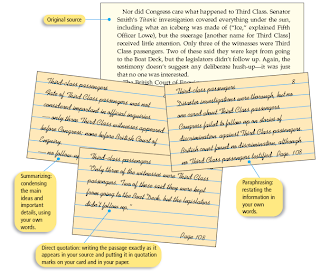Select a topic
(Click on the pictures to enlarge)
After making a schedule, select a topic. Spend some time in the library skimming books and encyclopedia articles . Researching and writing will be easier if you are curious about the topic you choose and if you find an approximate focus for your paper. Amy Colleen Bryan, a student at Lexington High School in Lexington, Virginia, was interested in the sinking of the Titanic in 1912.
Throughout this unit, you will see examples of notes, outlines, and drafts, and Amy’s final paper in Lesson 7.6. Besides your interests, consider what resources are available. If you have only one source on a topic, you will have only one viewpoint. On the other hand, selecting, condensing, and interpreting a mountain of information about a broad topic is difficult. This diagram shows how to identify an appropriate research paper topic.
Examine the Topic
As you continue to read about your topic, you will begin to determine your central idea. Examine your topic from various points of view.
Amy might have considered the following perspectives: How did the owners of the Titanic respond to the disaster? What did survivors recall about the sinking? Whom did investigators blame for the tragedy? Don’t worry if some angles lead to dead ends. For now just try to think critically about the topic from several perspectives.
To set a path for research, identify three to seven questions to answer first. As you answer these questions, you will discover others, as the diagram below shows. Let your central idea guide you in selecting questions.
Locate Information
You may use two types of sources—primary and secondary. A primary source is a firsthand account of an event, such as a Titanic survivor’s testimony before Congress. A secondary source is a secondhand account, such as an article analyzing the survivor’s comments. If possible, use primary sources to give your report a degree of authority that’s hard to achieve using only secondary sources. The chart below lists some basic sources used in social studies research. Some of the examples have their own Web sites or are available on CD-ROM.
Develop a working bibliography
As you begin your research, you will need to develop a working bibliography, a record of the books, articles, and other sources you will consult for your paper. Record the publication data for each appropriate source—including the publishing company, city, and date of publication—in a computer file or on a three-by-five-inch index card, as shown below. Number each source file or card in the upper right corner so that when you take notes, you can jot down the number of the source in which you find information. Preparing complete source files or cards now will help you compile your works-cited list at the end of your paper.Write notes to yourself as well, as shown on the magazine source card before.
Take notes
Just as you use cards when developing your working bibliography, you can use cards when taking notes. As you find a piece of information that answers one of your research questions, write it on a four-by-sixinch note card. In the upper right-hand corner of the note card, write the number of the source from the working bibliography.
You might want to put your initials by any of your own thoughts that you jot down on note cards. By initialing your own comments, you will be able to keep straight which information comes from other sources and which comes from your own interpretation.
Three ways of taking notes—paraphrasing, summarizing, and writing direct quotations—are shown previously.
Examine your sources critically
Because each source you use is written by a person with particular interests, knowledge, and values, be alert to each author’s bias. Find sources that approach your topic from different angles. Asking the following questions will help you critically evaluate your sources.
Avoid plagiarism
Presenting someone else’s ideas or expressions as your own is plagiarism, a form of cheating. Even when unintentional, plagiarism is a serious offense. You must give credit to the sources of information you use in your paper. To avoid plagiarism, keep clearly documented notes so you know where you found each piece of information.
Mr. Manuel Oviedo, B.A.






